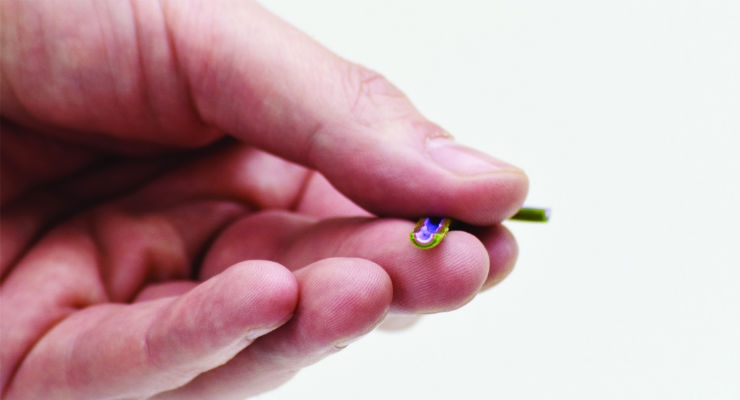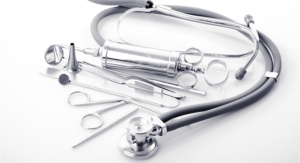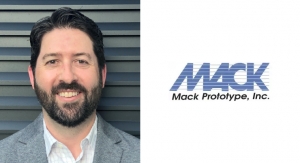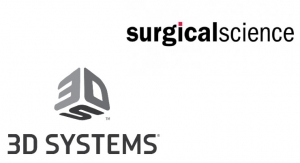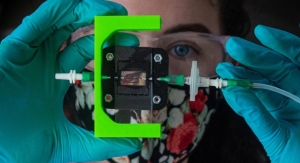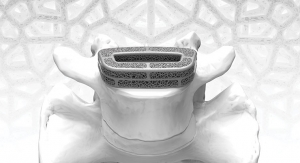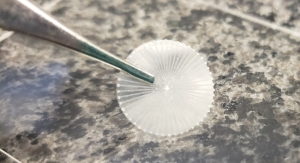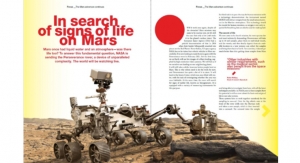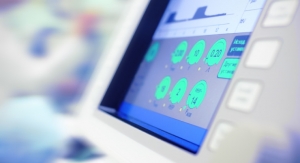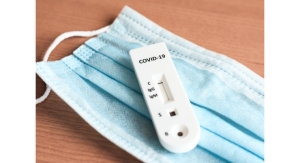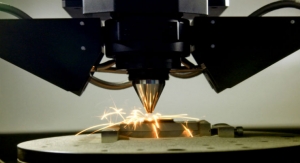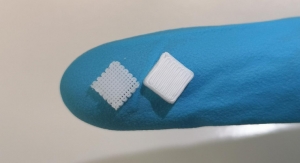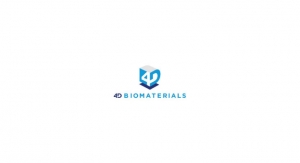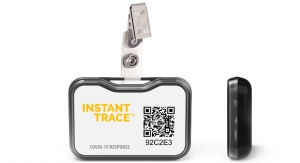Mark Crawford, Contributing Writer11.07.17
Additive manufacturing/3D printing (AM/3DP) is a rapidly evolving suite of manufacturing technologies that greatly expands design possibilities for medical devices—in fact, AM/3DP enables the creation of some complex products that cannot be made with conventional manufacturing methods. Advances in AM/3DP continue with a greater variety of engineered materials, tighter tolerances, larger build dimensions, and faster production speeds. These capabilities are driving more product development teams to adopt AM/3DP as a vital product development strategy moving forward. This is especially true in the orthopedic market.
“Medical device companies in the orthopedic and spine space are rapidly adopting 3D printing technology to introduce innovative products to the market,” said Gautam Gupta, vice president of business development and global sales, healthcare, for 3D Systems, a Denver, Colo.-based provider of 3D products and services for the medical device market. “Using 3D printing technology for implant production allows for complex design features, which can lead to significant clinical benefits. In addition, development of new products can be accomplished at a rapid pace with a reduction in cost.”
AM/3DP can be used in all phases of product development. For example, “a company can prototype a new device on a 3D printer, then test the device on an anatomical model that was 3D-printed from a patient scan,” said Michael Gaisford, director of marketing for Stratasys Healthcare Solutions, an Eden Prairie, Minn.-based provider of additive manufacturing solutions for the medical device industry. “Devices used in early clinical evaluation may be wholly or partly 3D-printed to save on production tooling. Once the product is launched, physicians can be trained by operating on 3D-printed anatomical models, prior to their first cases.”
In hospital settings, 3D printing serves as a tool for clinical care. Physicians use patient models to plan, practice, and determine optimal therapeutic approaches. Hospitals also use 3D printers to support hospital-based innovation, such as printing and testing prototypes and creating anatomy models for education and research.
“We use 3D printing technology and materials to create lifelike vascular environments that are not achievable any other way,” said Mike Springer, director of operations and entrepreneurship at the Jacobs Institute, a medical innovation institute in Buffalo, N.Y. “Instead of waiting to train on new procedures, physicians here use 3D-printed models of patients with stroke, clots, aneurysms, and other pathologies to develop surgical skills in a no-risk environment. Models are customized to present a range of anatomies so physician participants are exposed to the limits of what they will see when treating living patients.”
The use of AM/3DP extends beyond the actual printing of medical devices and models; it is increasingly used on-site to support manufacturing processes by producing the tools and fixtures that make these processes easier and more efficient, with less downtime.
“At first, AM/3DP was used for making prototype parts for our clients,” said Benjamin Harp, chief operating officer for Polymer Conversions, an Orchard Park, N.Y.-based contract manufacturer of plastic components and devices for the medical industry. “Now, we utilize the technology to make manufacturing aids and quality fixtures, and to support rapid tooling and molding of plastic components by utilizing printed tooling. We expect the technology will be used in all areas of our business going forward.”
What OEMs Want
Medical device manufacturers (MDMs) are eager to use AM/3DP to bring innovative new products into the market quickly. Most AM/3DP applications are for prototyping, which reduces iterations, speeds up production, and maximizes product quality. Both MDMs and their contract manufacturers (CMs) are becoming more familiar with what AM/3DP can do; for example, 3D printing can be ideal for low-volume production. It also saves money compared to traditional methods because it does not require heavy investment in expensive tooling and molds.
A number of MDMs are still cautious about embracing AM/3DP. CMs report that many clients want to learn more about the multiple ways AM/3DP can be utilized, and how to design these enhanced, AM/3DP-enabled functionalities into new products. OEMs also realize that the costs of prototyping, testing, and validating certain products can be greatly reduced, and timelines shortened, when these products are tested on accurate and life-like models.
“A long-term goal for AM is enabling OEMs to conduct virtual clinical trials to test new devices on 3D-printed models, rather than on live patients, and be able to submit device data for regulatory approval based on that testing,” said Gaisford. “This reduces the burden for clinical trials and also enables device companies to ensure their devices are tested on a range of clinical anatomy.”
Software Leads the Way
Popular AM/3DP technologies include powder bed fusion (selective laser sintering, direct metal laser sintering, e-beam) and vat photopolymerization (stereolithography). Many of the advances that increase the capabilities, efficiencies, and speeds of AM/3DP are software driven. For example, AM/3DP software now targets design optimization, data preparation, machine control and steering, workflow automation, and process and quality control.
Integrating 3D software and hardware is essential for improving manufacturing workflows and reducing production costs. For example, 3D Systems recently introduced a new software product called 3DXpert that interfaces seamlessly with metal 3D printers using CAD files, “which eliminates the need for file conversion and leads to better print quality and reduced file size,” said Gupta.
Improvements continue to be made in auto-segmentation software, which streamlines the 3D printing process by integrating the conversion of patient scans with the software that drives 3D printing equipment. For example, another 3D Systems product—D2P software—segments the patients’ digital imaging and communications in medicine data and delivers the output as an STL file that has been optimized for 3D printing. “The combination of the D2P software and the printing platforms enables medical professionals to have a complete technology solution,” said Gupta. “This means they can convert 2D data to 3D for improved visualization for use in pre-surgical planning. Such software and hardware platform integration has the potential to revolutionize the economics of manufacturing devices using 3D printing technology.”
Material Possibilities Abound
Materials companies continue to release advanced products with new or enhanced properties specifically designed for AM/3DP. AM equipment companies also make their own materials. For example, Stratasys recently launched Agilus30, a soft, rubber-like photopolymer with improved durability and tear strength. “This means MDMs can print thinner-walled anatomical structures like blood vessels and hearts and narrower channels, and better replicate the compliance of human anatomy, without the model failing,” said Gaisford.
These enhanced materials allow for the design and 3D printing of incredibly detailed models that can mimic a range of tissues that are even more realistic than processed cadavers, which no longer retain the feeling of live tissue. These models can also incorporate access points, sensors, and blood-flow simulation to enable highly dynamic and interactive training.
Qualifying new materials for AM/3DP in healthcare presents several challenges at multiple levels. First, the material must be qualified for its biocompatibility and ability to meet mechanical requirements for multiple applications. The associated regulatory and financial burdens of such qualification can be substantial.
For machine hardware engineering, validating and optimizing parameters to run new materials can be costly and time-consuming; therefore, MDMs prefer using existing proven materials, unless there is a business or clinical reason for using a new material. As such, in most cases, it is faster, easier, and less costly to qualify proven materials like 17-4 PH stainless steel and validate them for new AM applications.
One of the newest categories for AM/3DP materials is conductive thermoplastics. Calverton, N.Y.-based 3D Graphene Lab produces low-current, low-voltage conductive thermoplastic filaments with base resins of thermoplastic polyurethane or polylactic acid (PLA). Another company, Seattle, Wash.-based Functionalize, manufactures a highly conductive filament made from a PLA-based material. These materials enable the 3D printing of flexible conductors, circuits, batteries, and connections, which in the near future could result in the full 3D printing of wearable medical devices with integrated electronics.
AM/3DP Supports Traditional Manufacturing, Too
AM/3DP is a dynamically growing technology that also has the increasingly important role of supporting traditional manufacturing methods by making customized tools and fixtures—for example, quick-turn, low-cost injection molding tools.
“We have made great strides in developing tooling that allows us to make close-to-production, indicative molded components,” said Harp. “We believe that, with further capability in this area, we will be able to shatter the cost and time paradigm driven by typical mold building techniques. The resulting reductions in lead time and product development costs will encourage our OEM partners to create more new products, which is good for their business and good for the people who could benefit from these new devices.”
In addition, AM methods such as laser sintering allow the molding community to build tooling in a completely different way, added Harp. “For example,” he said, “the sintering process allows us to place cooling in areas of the tool that traditional tool-building techniques cannot achieve. By putting cooling closer to the part and in non-traditional areas, we are able to manufacture at reduced cycles and at tighter tolerances. This translates into better quality and better pricing.”
Additive manufacturing can also be used to make injection molding molds. Traditionally, these highly expensive molds are made from metal. However, Stratasys uses a digital acrylonitrile-butadiene-styrene (ABS) material that is strong enough to withstand the temperature of the molten plastic used in injection molding. Injection molds built with AM are far less expensive than metal molds and can be made within 24 hours. “This allows OEMs to prototype their molds and test designs and approaches, before committing the expense of manufacturing molds,” said Gaisford.
The Latest AM Technologies
Popular AM technologies include stereolithography, fused deposition modeling, digital light processing, and direct metal laser sintering. Stratasys has developed its PolyJet 3D printing technology, which is well-suited for prototyping and tooling. With microscopic layer resolution and an accuracy of ±0.1 mm, it can produce thin walls and complex geometries from a wide range of materials. Last year, the company launched the J750, a machine that can print up to six materials at once, including any combination of rigid, flexible, transparent, or opaque materials and their composites. Parts can be produced in over 360,000 colors, textures, gradients, transparencies, and durometers.
“The J750 allows us to create truly sophisticated anatomical models that combine soft tissue and hard bone, allow for color differentiation or color realism, and transparency into anatomical models,” said Gaisford.
Although there is frequently a learning curve when designing for AM/3DP, the tremendous design freedom it allows makes AM/3DP a true disrupter in the market. Capabilities are rapidly advancing. For example, 3D Systems’ ProX DMP 320 is high-performance metal additive manufacturing system that can be easily scaled for high-volume part production. Quick-swap build modules and fast powder recycling accelerate production and speed to market. A central server oversees print jobs, materials, settings, and maintenance. The high-quality surface finish/resolution produces parts and products that only require minimal post-processing.
“As this technology continues to improve,” said Gupta, “there will be even less post-processing required, thus making 3D printing highly attractive from a design flexibility and total cost of ownership point of view.”
Ultrasonic additive manufacturing (UAM) is a lesser-known process that uses sound waves to bind layers of metal together, drawn from thin metal foils, then followed by subtractive milling operations to generate near net shape metallic parts. The process produces true metallurgical bonds with full density, from a variety of metals. Electronic components such as microprocessors and sensors can also be embedded in a solid metal part using UAM because the process works at very low temperatures in a normal shop environment (typically below 250 degrees F). Since the materials are only slightly heated, the materials have no heat-affected zones and, therefore, do not require any related post-processing steps. Printing speeds can range up to 30 cubic inches per hour.
A common problem with AM/3DP is the need for secondary processing, which also includes removing the part from its support. This extends cycle time and adds cost. Another limitation with many AM technologies is the weakness of the bonds between the layers along the Z axis (the direction of deposition). So, although an injection-molded part might be nearly 100 percent isotropic (equally strong in all directions), typical AM parts lose about 40 percent of their Z-strength. A new 3D printing technology on the market, however, eliminates these problems.
Manufactured by Rize, a Woburn, Mass.-based 3D printer manufacturer, it uses an augmented polymer deposition (APD) process. APD involves the simultaneous extrusion of proprietary compounds of engineering- and medical-grade thermoplastics and jetting functional inks to change the material properties of the thermoplastic at the voxel level. This enables the jetting of an ink between the support material and the part for a quick and safe support removal immediately following printing; a marking ink is used for 3D printing detailed text and images in and on parts. The final parts have an isotropic strength that is stronger than ABS, polycarbonate, and carbon fiber-reinforced parts in the Z-axis. They also show high chemical resistance and can be sterilized. Some medical companies are using these 3D printers for prototypes and functional parts, including end-use production parts in small batches for clinical trials, customized prosthetics, and accurate models for pre-surgical planning and clinical education.
Arburg, a Lossburg, Germany-based injection molding company, has developed its Arburg Plastic Freeforming process as an alternative to injection molding. This technology produces one-off parts or small batches from qualified standard granulates, without using a mold. Unlike conventional AM techniques, the APF granulates are melted and the tiny droplets of plastic are precisely distributed to build the part using 3D CAD data. The APF equipment is outfitted with a movable three-axis part carrier and two stationary discharge units (the second unit can be used for an additional component to create special tactile qualities or hard-soft combinations). Arburg has already used this unique additive process to produce customized facial and cranial bone implants from medical polylactide.
A relatively new development in the medical industry is the 3D printing of silicone. Researchers at the University of Florida recently announced a 3D printing process that uses a new soft silicone material they designed for the 3D printing of high-use items such as ports for draining bodily fluids, implantable bands, balloons, soft catheters, slings, and meshes. This is of special interest to the medical device industry because these devices are currently molded, which can take up to days or weeks to create customized parts designed to fit individual patients. 3D printing these products cuts the wait time to just a few hours. What makes this process more effective than traditional silicone implant printing is the replacement of the water-based granular gel with micro-organogel material (similar to mineral oil) to help the non-polar, oily silicone set into desired shapes, without sagging or collapsing. The silicone is 3D-printed into the micro-organogel material, which provides support for the liquid silicone as it is 3D printing, allowing the creation of very complex structures and even encapsulated parts out of silicone elastomer.
“We were able to achieve really excellent 3D-printed silicone parts—the best I’ve seen,” reported Tommy Angelini, associate professor of mechanical and aerospace at the University of Florida and leader of the research team.
Moving Forward
AM equipment manufacturers (sometimes in partnership with OEMs) are working hard to improve overall build speeds, improve processing efficiencies, and reduce costs. Having the capability to 3D print high-quality parts that require no post-processing reduces the number of iterations needed and shortens product development cycles. MDMs that incorporate AM have reported reduction in prototyping costs by up to 75 percent and development times shortened by up to 50 percent.
As AM technologies advance, more engineers and designers will go beyond prototyping and use AM to print further into the development process. Designs will continue to be more innovative and functional with better utilization of the design freedom that AM provides—perhaps even resulting in AM-manufactured, production/end-use parts. Companies are also hopeful that 3D printing of high-volume, end-use parts may become a reality in the near future.
MDMs also seek to use 3D printing to gain insight into clinical performance and device interactions with patient anatomy, so they can go into clinical trials with the best possible design.
Preclinical validation testing is greatly improved when physicians can evaluate devices in realistic anatomical models that accurately simulate clinical performance. “Recently, we tested how effectively a particular device could reach the brain, depending on tortuosity of the anatomy,” said Dr. Adnan Siddiqui, chief medical officer at the Jacobs Institute. “We designed a series of models with differing levels of tortuosity, then tested the devices. This is impossible to do in animals and patients, but 3D printing makes it an easy, smooth, streamlined process.”
What amazes Gaisford the most is how AM/3DP enables creative thinking in medical device engineering and design—especially when it comes to solving problems in innovative ways.
For example, Cardinal Glennon, a Stratasys Healthcare Solutions client, essentially hacked its own computerized tomography/magnetic resonance imaging software in order to export the data file of a heat map of a patient’s skull, with different colors representing thickness of the bone. “They printed this heat map skull on a J750 with full color capability and used the model to guide a surgeon’s dissection of the patient skull,” said Gaisford. “Using the heat map, they identified thicker regions of the skull that could be safely split in half, moving the removed sheet of healthy bone to areas of the skull that were missing bone. No one taught them to do this. They came up with this on their own and created an entirely new application for 3D printing. It’s truly astonishing.”
Mark Crawford is a full-time freelance business and marketing/communications writer based in Madison, Wis. His clients range from startups to global manufacturing leaders. He also writes a variety of feature articles for regional and national publications and is the author of five books.
“Medical device companies in the orthopedic and spine space are rapidly adopting 3D printing technology to introduce innovative products to the market,” said Gautam Gupta, vice president of business development and global sales, healthcare, for 3D Systems, a Denver, Colo.-based provider of 3D products and services for the medical device market. “Using 3D printing technology for implant production allows for complex design features, which can lead to significant clinical benefits. In addition, development of new products can be accomplished at a rapid pace with a reduction in cost.”
AM/3DP can be used in all phases of product development. For example, “a company can prototype a new device on a 3D printer, then test the device on an anatomical model that was 3D-printed from a patient scan,” said Michael Gaisford, director of marketing for Stratasys Healthcare Solutions, an Eden Prairie, Minn.-based provider of additive manufacturing solutions for the medical device industry. “Devices used in early clinical evaluation may be wholly or partly 3D-printed to save on production tooling. Once the product is launched, physicians can be trained by operating on 3D-printed anatomical models, prior to their first cases.”
In hospital settings, 3D printing serves as a tool for clinical care. Physicians use patient models to plan, practice, and determine optimal therapeutic approaches. Hospitals also use 3D printers to support hospital-based innovation, such as printing and testing prototypes and creating anatomy models for education and research.
“We use 3D printing technology and materials to create lifelike vascular environments that are not achievable any other way,” said Mike Springer, director of operations and entrepreneurship at the Jacobs Institute, a medical innovation institute in Buffalo, N.Y. “Instead of waiting to train on new procedures, physicians here use 3D-printed models of patients with stroke, clots, aneurysms, and other pathologies to develop surgical skills in a no-risk environment. Models are customized to present a range of anatomies so physician participants are exposed to the limits of what they will see when treating living patients.”
The use of AM/3DP extends beyond the actual printing of medical devices and models; it is increasingly used on-site to support manufacturing processes by producing the tools and fixtures that make these processes easier and more efficient, with less downtime.
“At first, AM/3DP was used for making prototype parts for our clients,” said Benjamin Harp, chief operating officer for Polymer Conversions, an Orchard Park, N.Y.-based contract manufacturer of plastic components and devices for the medical industry. “Now, we utilize the technology to make manufacturing aids and quality fixtures, and to support rapid tooling and molding of plastic components by utilizing printed tooling. We expect the technology will be used in all areas of our business going forward.”
What OEMs Want
Medical device manufacturers (MDMs) are eager to use AM/3DP to bring innovative new products into the market quickly. Most AM/3DP applications are for prototyping, which reduces iterations, speeds up production, and maximizes product quality. Both MDMs and their contract manufacturers (CMs) are becoming more familiar with what AM/3DP can do; for example, 3D printing can be ideal for low-volume production. It also saves money compared to traditional methods because it does not require heavy investment in expensive tooling and molds.
A number of MDMs are still cautious about embracing AM/3DP. CMs report that many clients want to learn more about the multiple ways AM/3DP can be utilized, and how to design these enhanced, AM/3DP-enabled functionalities into new products. OEMs also realize that the costs of prototyping, testing, and validating certain products can be greatly reduced, and timelines shortened, when these products are tested on accurate and life-like models.
“A long-term goal for AM is enabling OEMs to conduct virtual clinical trials to test new devices on 3D-printed models, rather than on live patients, and be able to submit device data for regulatory approval based on that testing,” said Gaisford. “This reduces the burden for clinical trials and also enables device companies to ensure their devices are tested on a range of clinical anatomy.”
Software Leads the Way
Popular AM/3DP technologies include powder bed fusion (selective laser sintering, direct metal laser sintering, e-beam) and vat photopolymerization (stereolithography). Many of the advances that increase the capabilities, efficiencies, and speeds of AM/3DP are software driven. For example, AM/3DP software now targets design optimization, data preparation, machine control and steering, workflow automation, and process and quality control.
Integrating 3D software and hardware is essential for improving manufacturing workflows and reducing production costs. For example, 3D Systems recently introduced a new software product called 3DXpert that interfaces seamlessly with metal 3D printers using CAD files, “which eliminates the need for file conversion and leads to better print quality and reduced file size,” said Gupta.
Improvements continue to be made in auto-segmentation software, which streamlines the 3D printing process by integrating the conversion of patient scans with the software that drives 3D printing equipment. For example, another 3D Systems product—D2P software—segments the patients’ digital imaging and communications in medicine data and delivers the output as an STL file that has been optimized for 3D printing. “The combination of the D2P software and the printing platforms enables medical professionals to have a complete technology solution,” said Gupta. “This means they can convert 2D data to 3D for improved visualization for use in pre-surgical planning. Such software and hardware platform integration has the potential to revolutionize the economics of manufacturing devices using 3D printing technology.”
Material Possibilities Abound
Materials companies continue to release advanced products with new or enhanced properties specifically designed for AM/3DP. AM equipment companies also make their own materials. For example, Stratasys recently launched Agilus30, a soft, rubber-like photopolymer with improved durability and tear strength. “This means MDMs can print thinner-walled anatomical structures like blood vessels and hearts and narrower channels, and better replicate the compliance of human anatomy, without the model failing,” said Gaisford.
These enhanced materials allow for the design and 3D printing of incredibly detailed models that can mimic a range of tissues that are even more realistic than processed cadavers, which no longer retain the feeling of live tissue. These models can also incorporate access points, sensors, and blood-flow simulation to enable highly dynamic and interactive training.
Qualifying new materials for AM/3DP in healthcare presents several challenges at multiple levels. First, the material must be qualified for its biocompatibility and ability to meet mechanical requirements for multiple applications. The associated regulatory and financial burdens of such qualification can be substantial.
For machine hardware engineering, validating and optimizing parameters to run new materials can be costly and time-consuming; therefore, MDMs prefer using existing proven materials, unless there is a business or clinical reason for using a new material. As such, in most cases, it is faster, easier, and less costly to qualify proven materials like 17-4 PH stainless steel and validate them for new AM applications.
One of the newest categories for AM/3DP materials is conductive thermoplastics. Calverton, N.Y.-based 3D Graphene Lab produces low-current, low-voltage conductive thermoplastic filaments with base resins of thermoplastic polyurethane or polylactic acid (PLA). Another company, Seattle, Wash.-based Functionalize, manufactures a highly conductive filament made from a PLA-based material. These materials enable the 3D printing of flexible conductors, circuits, batteries, and connections, which in the near future could result in the full 3D printing of wearable medical devices with integrated electronics.
AM/3DP Supports Traditional Manufacturing, Too
AM/3DP is a dynamically growing technology that also has the increasingly important role of supporting traditional manufacturing methods by making customized tools and fixtures—for example, quick-turn, low-cost injection molding tools.
“We have made great strides in developing tooling that allows us to make close-to-production, indicative molded components,” said Harp. “We believe that, with further capability in this area, we will be able to shatter the cost and time paradigm driven by typical mold building techniques. The resulting reductions in lead time and product development costs will encourage our OEM partners to create more new products, which is good for their business and good for the people who could benefit from these new devices.”
In addition, AM methods such as laser sintering allow the molding community to build tooling in a completely different way, added Harp. “For example,” he said, “the sintering process allows us to place cooling in areas of the tool that traditional tool-building techniques cannot achieve. By putting cooling closer to the part and in non-traditional areas, we are able to manufacture at reduced cycles and at tighter tolerances. This translates into better quality and better pricing.”
Additive manufacturing can also be used to make injection molding molds. Traditionally, these highly expensive molds are made from metal. However, Stratasys uses a digital acrylonitrile-butadiene-styrene (ABS) material that is strong enough to withstand the temperature of the molten plastic used in injection molding. Injection molds built with AM are far less expensive than metal molds and can be made within 24 hours. “This allows OEMs to prototype their molds and test designs and approaches, before committing the expense of manufacturing molds,” said Gaisford.
The Latest AM Technologies
Popular AM technologies include stereolithography, fused deposition modeling, digital light processing, and direct metal laser sintering. Stratasys has developed its PolyJet 3D printing technology, which is well-suited for prototyping and tooling. With microscopic layer resolution and an accuracy of ±0.1 mm, it can produce thin walls and complex geometries from a wide range of materials. Last year, the company launched the J750, a machine that can print up to six materials at once, including any combination of rigid, flexible, transparent, or opaque materials and their composites. Parts can be produced in over 360,000 colors, textures, gradients, transparencies, and durometers.
“The J750 allows us to create truly sophisticated anatomical models that combine soft tissue and hard bone, allow for color differentiation or color realism, and transparency into anatomical models,” said Gaisford.
Although there is frequently a learning curve when designing for AM/3DP, the tremendous design freedom it allows makes AM/3DP a true disrupter in the market. Capabilities are rapidly advancing. For example, 3D Systems’ ProX DMP 320 is high-performance metal additive manufacturing system that can be easily scaled for high-volume part production. Quick-swap build modules and fast powder recycling accelerate production and speed to market. A central server oversees print jobs, materials, settings, and maintenance. The high-quality surface finish/resolution produces parts and products that only require minimal post-processing.
“As this technology continues to improve,” said Gupta, “there will be even less post-processing required, thus making 3D printing highly attractive from a design flexibility and total cost of ownership point of view.”
Ultrasonic additive manufacturing (UAM) is a lesser-known process that uses sound waves to bind layers of metal together, drawn from thin metal foils, then followed by subtractive milling operations to generate near net shape metallic parts. The process produces true metallurgical bonds with full density, from a variety of metals. Electronic components such as microprocessors and sensors can also be embedded in a solid metal part using UAM because the process works at very low temperatures in a normal shop environment (typically below 250 degrees F). Since the materials are only slightly heated, the materials have no heat-affected zones and, therefore, do not require any related post-processing steps. Printing speeds can range up to 30 cubic inches per hour.
A common problem with AM/3DP is the need for secondary processing, which also includes removing the part from its support. This extends cycle time and adds cost. Another limitation with many AM technologies is the weakness of the bonds between the layers along the Z axis (the direction of deposition). So, although an injection-molded part might be nearly 100 percent isotropic (equally strong in all directions), typical AM parts lose about 40 percent of their Z-strength. A new 3D printing technology on the market, however, eliminates these problems.
Manufactured by Rize, a Woburn, Mass.-based 3D printer manufacturer, it uses an augmented polymer deposition (APD) process. APD involves the simultaneous extrusion of proprietary compounds of engineering- and medical-grade thermoplastics and jetting functional inks to change the material properties of the thermoplastic at the voxel level. This enables the jetting of an ink between the support material and the part for a quick and safe support removal immediately following printing; a marking ink is used for 3D printing detailed text and images in and on parts. The final parts have an isotropic strength that is stronger than ABS, polycarbonate, and carbon fiber-reinforced parts in the Z-axis. They also show high chemical resistance and can be sterilized. Some medical companies are using these 3D printers for prototypes and functional parts, including end-use production parts in small batches for clinical trials, customized prosthetics, and accurate models for pre-surgical planning and clinical education.
Arburg, a Lossburg, Germany-based injection molding company, has developed its Arburg Plastic Freeforming process as an alternative to injection molding. This technology produces one-off parts or small batches from qualified standard granulates, without using a mold. Unlike conventional AM techniques, the APF granulates are melted and the tiny droplets of plastic are precisely distributed to build the part using 3D CAD data. The APF equipment is outfitted with a movable three-axis part carrier and two stationary discharge units (the second unit can be used for an additional component to create special tactile qualities or hard-soft combinations). Arburg has already used this unique additive process to produce customized facial and cranial bone implants from medical polylactide.
A relatively new development in the medical industry is the 3D printing of silicone. Researchers at the University of Florida recently announced a 3D printing process that uses a new soft silicone material they designed for the 3D printing of high-use items such as ports for draining bodily fluids, implantable bands, balloons, soft catheters, slings, and meshes. This is of special interest to the medical device industry because these devices are currently molded, which can take up to days or weeks to create customized parts designed to fit individual patients. 3D printing these products cuts the wait time to just a few hours. What makes this process more effective than traditional silicone implant printing is the replacement of the water-based granular gel with micro-organogel material (similar to mineral oil) to help the non-polar, oily silicone set into desired shapes, without sagging or collapsing. The silicone is 3D-printed into the micro-organogel material, which provides support for the liquid silicone as it is 3D printing, allowing the creation of very complex structures and even encapsulated parts out of silicone elastomer.
“We were able to achieve really excellent 3D-printed silicone parts—the best I’ve seen,” reported Tommy Angelini, associate professor of mechanical and aerospace at the University of Florida and leader of the research team.
Moving Forward
AM equipment manufacturers (sometimes in partnership with OEMs) are working hard to improve overall build speeds, improve processing efficiencies, and reduce costs. Having the capability to 3D print high-quality parts that require no post-processing reduces the number of iterations needed and shortens product development cycles. MDMs that incorporate AM have reported reduction in prototyping costs by up to 75 percent and development times shortened by up to 50 percent.
As AM technologies advance, more engineers and designers will go beyond prototyping and use AM to print further into the development process. Designs will continue to be more innovative and functional with better utilization of the design freedom that AM provides—perhaps even resulting in AM-manufactured, production/end-use parts. Companies are also hopeful that 3D printing of high-volume, end-use parts may become a reality in the near future.
MDMs also seek to use 3D printing to gain insight into clinical performance and device interactions with patient anatomy, so they can go into clinical trials with the best possible design.
Preclinical validation testing is greatly improved when physicians can evaluate devices in realistic anatomical models that accurately simulate clinical performance. “Recently, we tested how effectively a particular device could reach the brain, depending on tortuosity of the anatomy,” said Dr. Adnan Siddiqui, chief medical officer at the Jacobs Institute. “We designed a series of models with differing levels of tortuosity, then tested the devices. This is impossible to do in animals and patients, but 3D printing makes it an easy, smooth, streamlined process.”
What amazes Gaisford the most is how AM/3DP enables creative thinking in medical device engineering and design—especially when it comes to solving problems in innovative ways.
For example, Cardinal Glennon, a Stratasys Healthcare Solutions client, essentially hacked its own computerized tomography/magnetic resonance imaging software in order to export the data file of a heat map of a patient’s skull, with different colors representing thickness of the bone. “They printed this heat map skull on a J750 with full color capability and used the model to guide a surgeon’s dissection of the patient skull,” said Gaisford. “Using the heat map, they identified thicker regions of the skull that could be safely split in half, moving the removed sheet of healthy bone to areas of the skull that were missing bone. No one taught them to do this. They came up with this on their own and created an entirely new application for 3D printing. It’s truly astonishing.”
Mark Crawford is a full-time freelance business and marketing/communications writer based in Madison, Wis. His clients range from startups to global manufacturing leaders. He also writes a variety of feature articles for regional and national publications and is the author of five books.

